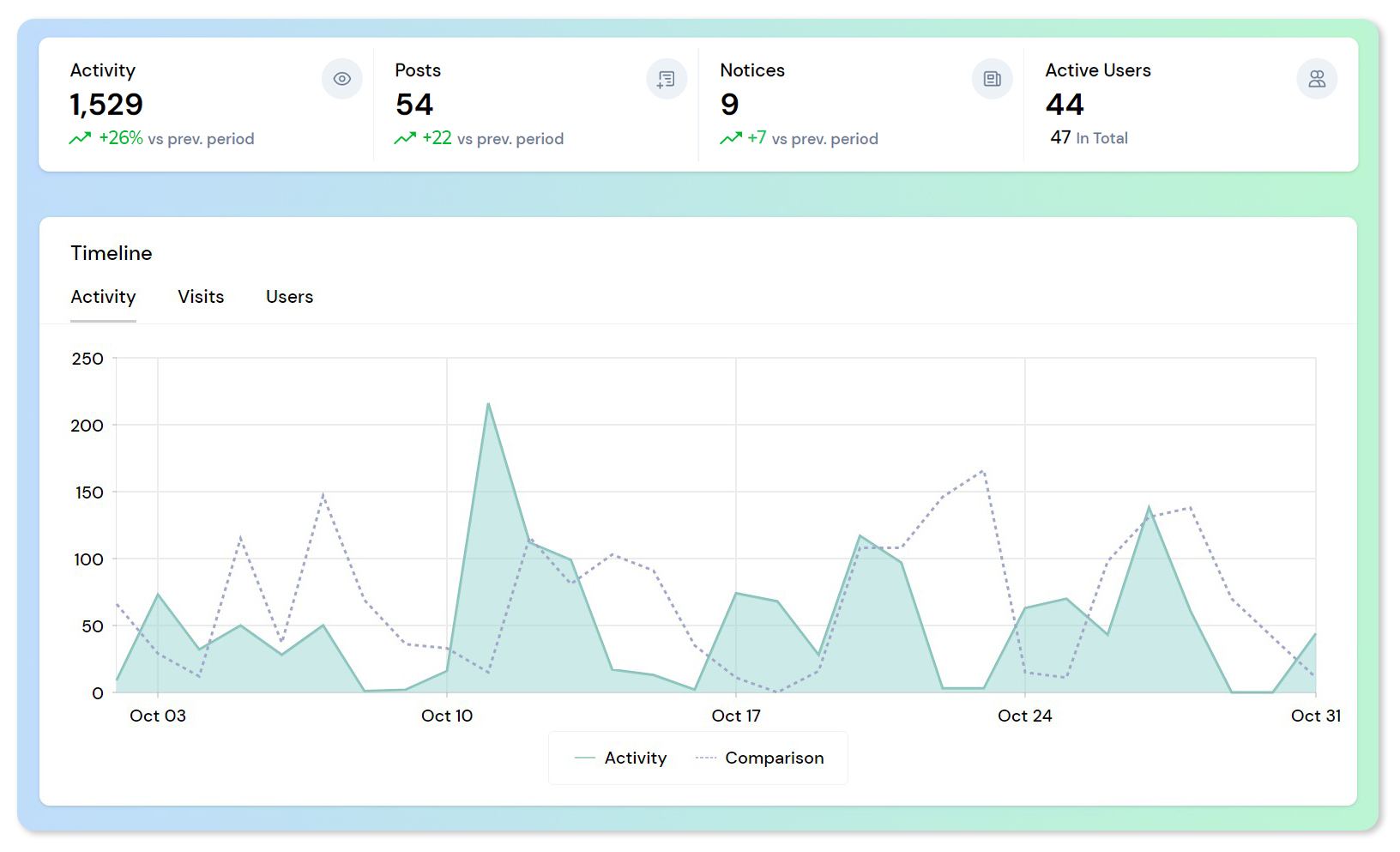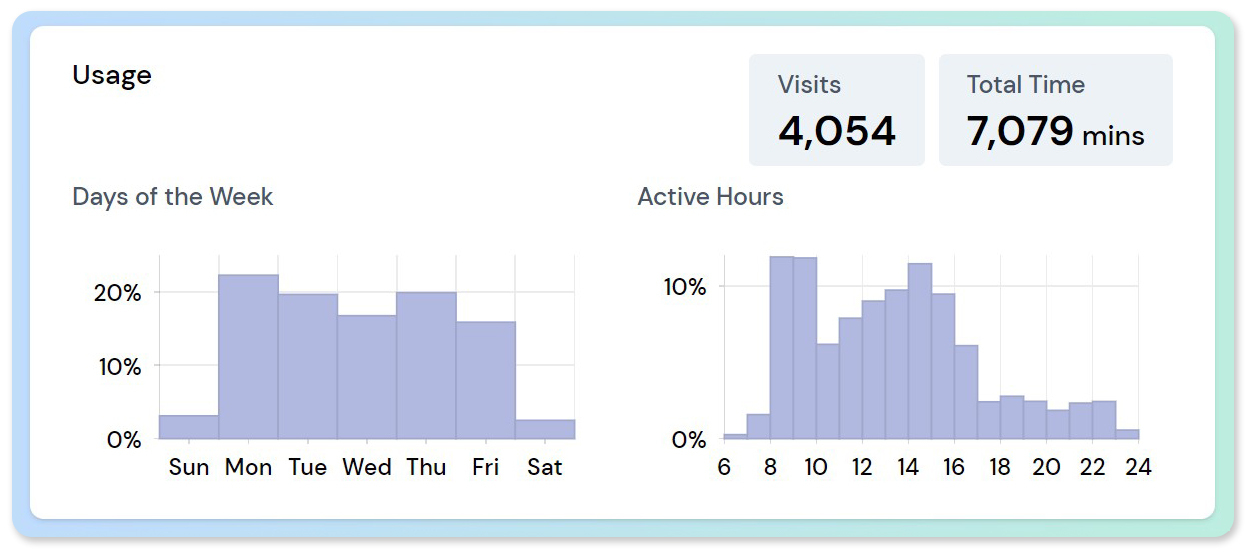Most companies are aware of the importance of various KPIs as well as other measures when it comes to assessing business performance. What often gets overlooked, however, is the need to measure internal communication.
This is a mistake, as effective internal communication is essential for any organization in order to ensure that employees are kept informed and motivated and that they understand the company’s goals and how their role fits into achieving these.

And how would you know if its effective if you do not meassure it?
In this article, we'll take a look at what internal communication is, why it's important to measure it, and some of the key internal communication metrics that you should be tracking.
The Importance of Internal Communication
Internal communication is any form of communication that takes place within an organization - between employees at all levels.
It includes everything from formal announcements and company-wide emails to more informal conversations in the break room.
And it's something that will happen whether you as a company actively encourage and invest in it or not. The question is, how effective will it be?
Poor internal communication can result in a lack of engagement and motivation among employees. If they don't understand the company's goals or how their role fits into achieving these, then it's difficult for them to feel invested in their work.
Besides causing job dissatisfaction, it can also have a negative impact on overall performance and productivity. Inefficient communication can lead to confusion and mistakes, which can in turn cost the company time and money.
So leaving things to chance is not an option when it comes to internal communication. You need to actively manage and invest in it if you want to ensure that your employees are kept informed, engaged, and motivated.
And part of doing this effectively is measuring your internal communication.
The Importance of Tracking Internal Communication Metrics
Modern work environments, such as remote work and global organizations, have made internal communications more important—and more challenging—than ever before.
In order to manage IC effectively in these complex environments, you need to have a clear understanding of what's working and what isn't.
This is where tracking internal communication metrics comes in.
Measuring internal communication allows you to:
- Gain insights into how employees feel about the company and their work
- Identify any problems or areas of confusion
- Monitor the effectiveness of your internal communication strategy
- Make changes and adjust your approach as necessary
In other words, measuring internal communication is essential for ensuring that your employees are kept informed, engaged, and motivated.
Yet 33% of businesses are not measuring their internal communications and 78% are not satisfied with their organization’s ability to measure internal communication.
This is a problem because, without tracking internal communication metrics, it's difficult to know what's working and what isn't. As a result, you could be wasting time and resources on ineffective strategies and missing out on opportunities to improve communication in the workplace.
Why Is This So Tricky?
So if both the importance of internal communication and the need to measure it are clear, why is it that so many businesses struggle to do so effectively?
Well, because you'll need a somewhat creative approach when it comes to internal communication metrics.
This is because internal communication is unique in that its primary goal is not to generate revenue or leads but rather to maintain employee engagement and motivation, which in itself is not easy to measure.
It's also important to remember that internal communication is not a one-way street. Unlike marketing or advertising, which are designed to be consumed by the audience, internal communication relies on two-way dialogue. This makes it more complex to measure.
However, just because measuring internal communication is tricky, this doesn't mean that it's impossible. There are a number of different internal communication metrics that you can track in order to get valuable insights into your strategy.
Key Internal Communication Metrics That You Should Be Tracking
In order to get a picture of how effective your internal communication is, you need to track a variety of different metrics. Some are quiet on the nose, whereas others are more out of the box.
The key here is to figure out what your strategy is trying to achieve and then identify the metrics that will give you insights into whether or not this is happening.
With that in mind, here are some of the most important internal communication metrics that you should be tracking:
1. Open and Click-Through Rates
Let's start with the basics, after all, what good is any communication if nobody reads it? While external communications like email marketing are typically measured by open and click-through rates, the same can be done for internal communications.
Open rates will give you an indication of how many employees are actually reading your internal communications. Click-through rates will tell you how engaged they are with the content.
If you notice a sudden drop in either of these metrics, it could be an indication that something is wrong. Maybe the content is no longer relevant to employees, or perhaps they're not receiving the communications in a format that works for them.
2. Employee Engagement Rates
This is your most important measure of internal communication effectiveness.
Employee engagement is a measure of how connected and committed employees are to their work and the company.
And since one of your top goals with internal communication is to keep employees engaged and motivated, it makes sense to track this metric closely.
There are a number of different ways to measure employee engagement, but one of the most common is through employee surveys. You can also track engagement indirectly by looking at measures such as absenteeism, staff turnover, and productivity levels.

Some communication channels, such as social intranets, will make this even easier by providing you with direct feedback from employees in the form of likes, comments, and shares - all neatly packed into one dashboard.
3. Communication Frequency
If you're bombarding employees with too many messages, they're likely to tune out. On the other hand, if you're not communicating enough, then employees will quickly become disengaged.
Finding the right balance can be tricky, but it's important to get it right. After all, the frequency of your internal communications will have a direct impact on employee engagement levels.
One way to measure communication frequency is to track how often employees are interacting with your company's intranet or internal communications platform. If you notice a sharp drop-off, then it could be an indication that you need to rethink your strategy.
4. Adoption Rates for New Channels and Technologies
With the ever-changing landscape of communication, it's important to keep up with the latest trends and technologies. This means regularly introducing new channels and tools into your IC mix.
However, just because you introduce a new tool doesn't mean that employees will actually use it. Getting people on board with new technology was never easy, and some will downright refuse to adopt new tools.
In order to gauge whether employees are adopting new channels and technologies, you need to track adoption rates.
Adoption rates will tell you how many employees are using a new channel or tool and how often they're using it. This metric is especially important in the early stages of rollout when you're trying to get employees on board with a new way of communicating.
5. Added Value
This is where it gets tricky. Most organizations think about internal communications in terms of efficiency - how quickly can we get this message out to employees?
But if you want to truly measure the effectiveness of your internal communications, you need to start thinking about added value. What are employees getting from your communications that they couldn't get anywhere else?
This could be anything from timely updates on company news to access to exclusive content and resources. It's important to think about what added value your communications are offering employees and whether they're finding it valuable.
6. Time Spent Finding Information
The goal of internal communications is to make it easy for employees to find the information they need when they need it. So if you notice that employees are spending a lot of time searching for information, it could be an indication that your communications are not effective.
How do you measure this? You could start by surveying employees to find out how long they spend looking for information. You could also track the number of times employees contact the help desk or HR for information.
Or just ask your senior employees how much time they spend each day answering questions from junior employees. This will give you a good idea of how much time is being wasted searching for information.
7. Costs Vs. Benefit
This is the big one. How much money is your organization spending on internal communications? And how much is it getting back in return?
ROI is the ultimate measure of success for any business activity, and internal communications are no different. To calculate ROI, you need to consider both the costs and the benefits of your internal communications.
